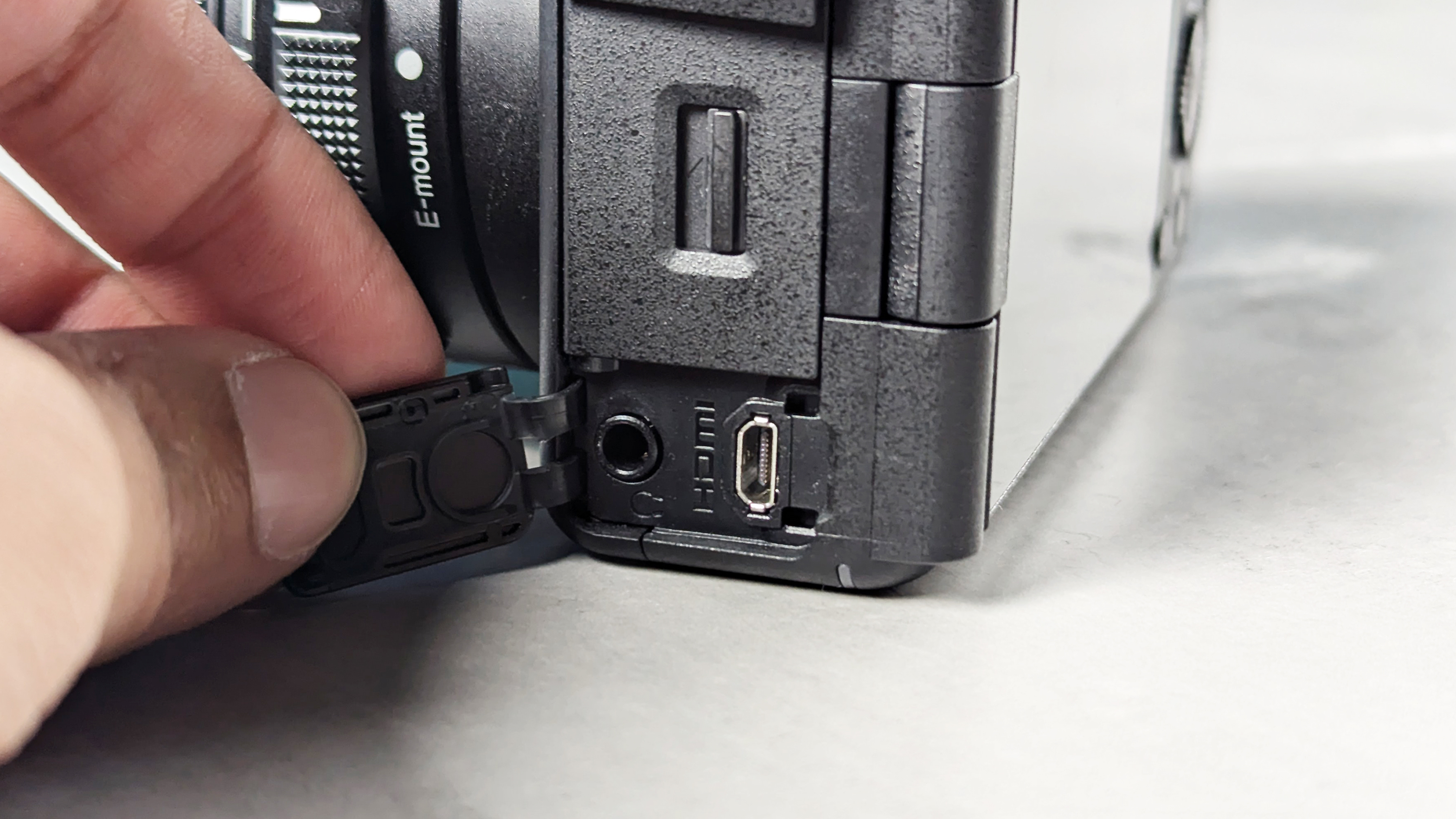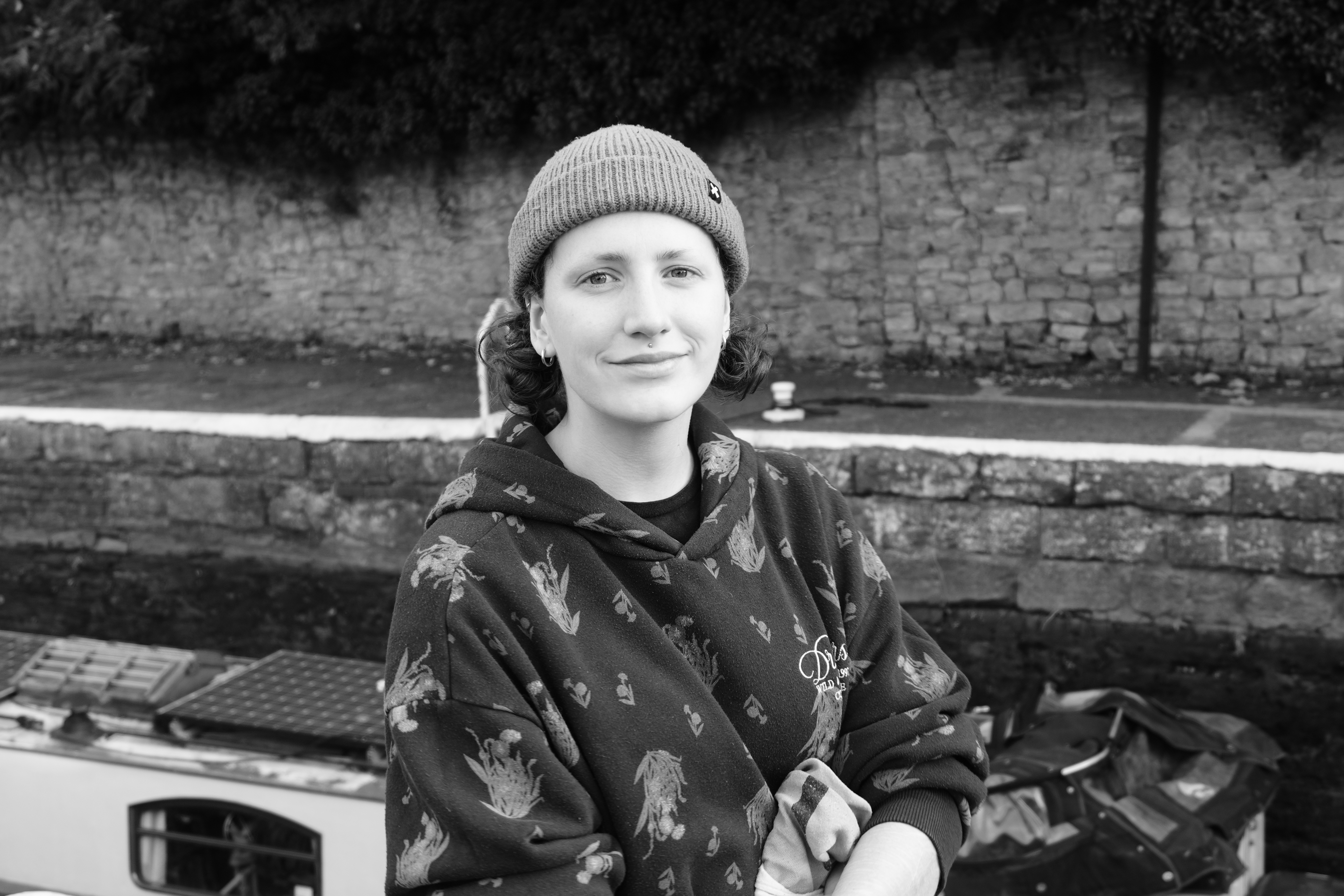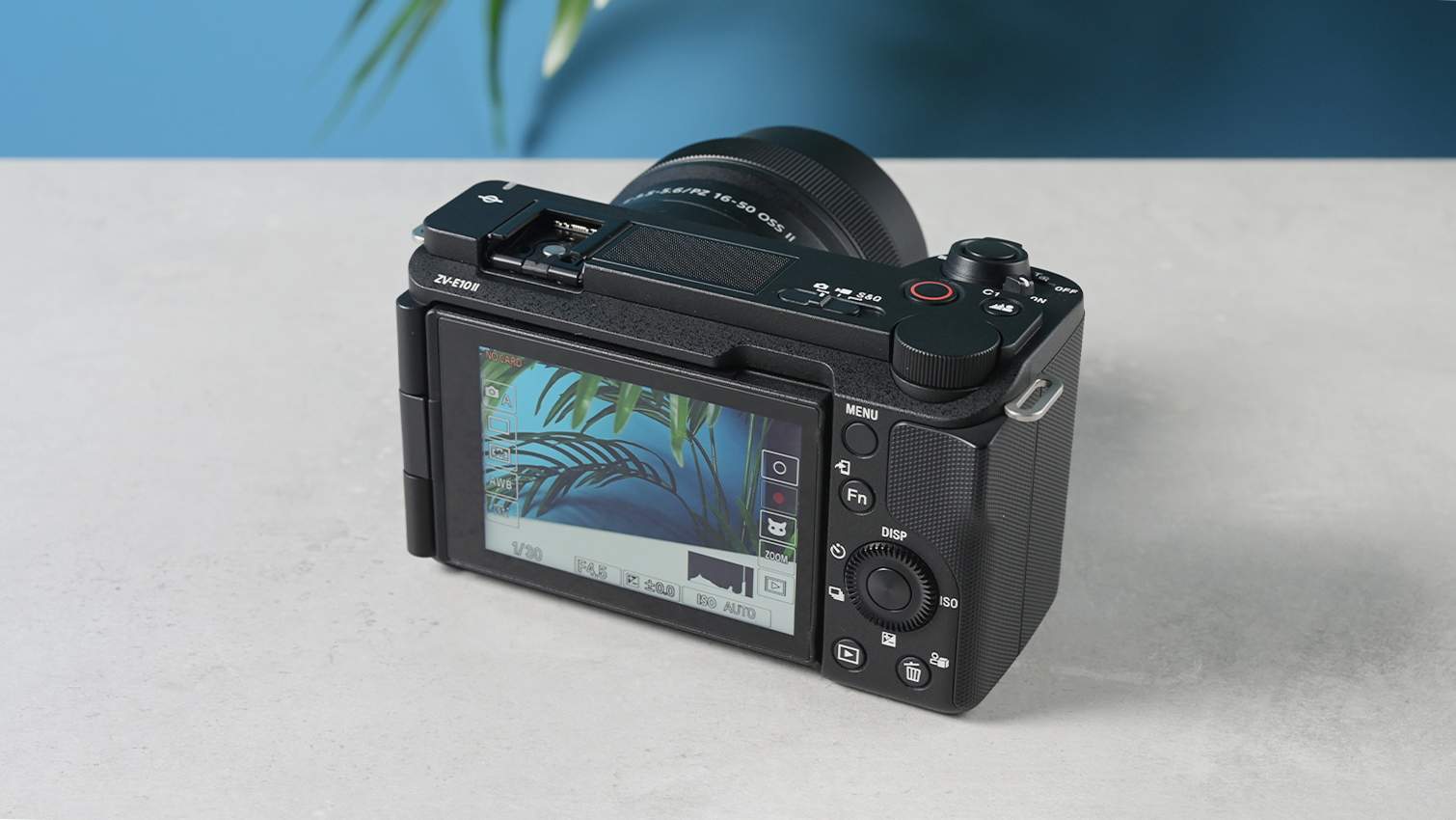Tom's Guide Verdict
Capable of recording 4K/60P video in 10-bit color, capturing gorgeous stills with its 26MP sensor, and tracking subjects with a reliable hybrid AF system, the Sony ZV-E10 II is an excellent camera for content creators. It also boasts a long battery life, but $999 won’t get you in-body image stabilization, weather-sealing or a viewfinder.
Pros
- +
Compact and portable
- +
Comfortable to hold
- +
Excellent autofocus
- +
Gorgeous 4K/60P footage
- +
Long battery life
Cons
- -
No viewfinder
- -
No in-body image stabilization
- -
Not weather-sealed
Why you can trust Tom's Guide
If you’re a serious content creator or vlogger, you need equally serious gear that won’t let you down — that means picking up one of the best cameras with a long battery life and the ability to capture smooth, professional-looking footage. The Sony ZV-E10 II might be right up your alley if you’re looking for all that in a compact and portable body.
The ZV-E10 II succeeds the first-gen model and introduces a few useful upgrades, such as 4K/60P 10-bit video, improved hybrid autofocus, and a bigger battery. Perfect for travel content creators, the ZV-E10 II is highly portable, comfortable to hold and easy to use. It captures lovely cinematic footage that barely needs editing, and its 26MP sensor produces detailed stills too. But the camera is far from perfect, as it isn’t weather-sealed, doesn’t have a viewfinder, and digital stabilization adds a hefty crop to footage.
For the complete breakdown, read my full Sony ZV-E10 II review.
Sony ZV-E10 II review: Specs
| Specs | Sony ZV-E10 II |
|---|---|
| Sensor | 26MP APS-C Exmor R CMOS |
| Processor | BIONZ XR |
| Stabilization | Electronic |
| AF system | Focal plane phase-detection AF |
| Viewfinder | No |
| Display | 3-inch Color LCD touchscreen, approx. 1.037 million dots |
| ISO range | 100-32,000 (expandable to 50-102,400) |
| Max video resolution | 4K at 60P |
| Ports | USB-C, Micro HDMI, 3.5mm external mic, 1x SDXC UHS-II |
| Wireless/bluetooth | Wi-Fi, Bluetooth |
| Max shooting speed | 11fps electronic |
| Max shutter speed | 1/8000 to 30s (stills) | 1/8000 to 1s (movies) |
| Battery life (CIPA) | 610 shots; 195 minutes |
| Size | 4.51 x 2.65 x 2.11 inches |
| Weight | 10.3oz (body only) |
Sony ZV-E10 II review: Cheat sheet
- What is it? An APS-C interchangeable lens vlogging camera
- Who is it for? For content creators who prioritize video over stills
- How much does it cost? The Sony ZV-E10 II starts at $999 / £925 and goes up to $1,099 / £999
- What do we like? The compact and lightweight build, cinematic footage, 4K/60P 10-bit video, excellent autofocus, and long battery life
- What don’t we like? There’s no viewfinder, stabilization adds a significant crop, and it isn’t weather-sealed
Sony ZV-E10 II review: Price & availability

Launched in Summer 2024, the Sony ZV-E10 II succeeds the first-gen ZV-E10 after three years, and is available in black only. The camera starts at $999 at Amazon U.S. / £925 at Amazon U.K., body only. You can get the bundle with the E PZ 16-50mm F3.5-5.6 OSS II kit lens, which costs $1,099 / £999. This is a massive price hike over the first-gen model, which costs $699 / £599, body only, and $799 / £699 with the kit lens.
The ZV-E10 II finds itself competing with the likes of the Fujifilm X-S20 ($1,299), the Canon EOS R10 ($979) and the Nikon Z 30 ($709).
Sony ZV-E10 II review: Design

The Sony ZV-E10 II retains much of its predecessor’s design, with negligible differences in size and weight. The ZV-E10 II is a very compact and lightweight camera, making it a great travel companion. It measures 4.51 x 2.65 x 2.11 inches so it’s easy to hold with just one hand, even for long periods, and comfortably slips into a bag. The sculpted grip protruding out of the right-hand side adds to the comfort and handling, too. The body weighs just 10.3 ounces and is slightly heavier than the first-gen model, and that’s down to the larger battery that the ZV-E10 II houses.

On the bottom of the ZV-E10 II, you’ll find the battery compartment and tripod mount. The left-hand side of the camera houses all the ports and the UHS-II memory card slot. You get ports for a 3.5mm external mic, micro HDMI, USB-C and external headphones.
Get instant access to breaking news, the hottest reviews, great deals and helpful tips.

A 3-inch flip-out articulating LCD touchscreen with a 1.037 million-dot display adorns the back of the camera. The Fujifilm X-S20’s screen, on the other hand, has 1.84 million dots, therefore producing a crisper image. I found the ZV-E10 II’s versatile tilting positions extremely handy for shooting stills and video at low angles — and even shooting selfies. The touchscreen is highly responsive, especially when you want to change shooting settings on the fly. The touchscreen’s UI is quite cluttered by default, but you can easily change the look and feel of it in the menu, so take your time with it to ensure the camera is exactly the way you want. Also, the UI automatically rotates depending on whether you’re shooting horizontally or vertically.
The camera doesn’t have a viewfinder to look through, which I found a little frustrating, particularly for stills. Relying on the LCD screen to compose shots in bright sunlight proved to be an issue as I couldn’t always see what the camera was pointing at.

The camera comes with a three-way capsule mic situated on the top plate, and a furry windshield to help clean up audio outdoors. However, it’s important to note that the ZV-E10 II isn’t weather-sealed which means you should avoid shooting in rain, snow or dusty environments. This isn’t surprising, given the price point, but it can be a little frustrating for outdoorsy vloggers. If you want a weather-sealed camera, you’re best off stepping up to the Sony a6700 ($1,400) instead.
Sony ZV-E10 II review: Controls

All the controls on the Sony ZV-E10 II are well laid out, and they’re all on the right-hand side of the camera. On the top plate, you’ll find the shutter release and power buttons, and a zoom rocker. The shutter button gave good tactile feedback upon pressing. Further back is the Mode button which lets you switch between stills, video and slow and quick motion (S&Q) video. The Mode button was really handy as I could quickly switch between stills and video and the camera took no time to react when out in the field. Next to this you’ll see a black and red record button, the C1/Background Defocus button, and a control dial to change aperture and or shutter speed. The ridges on the control dial ensured my fingertip didn’t slip off and I had full control at all times.

On the back of the camera and next to the LCD touchscreen, you get a flat command dial with four directional press commands. Other buttons, like Delete, Menu and Gallery, are self-explanatory. The Delete button also doubles as a Product Showcase Focus button.

The two buttons worth explaining are Background Defocus and Product Showcase Focus. Think of the first one as a dedicated bokeh button. Basically, it blurs the background by opening the lens to its widest aperture. The Product Showcase Focus button is great for content creators who do product unboxing videos, as pressing this button shifts focus to the object closest to the lens. Both these features worked well in my testing and they can help non-camera-savvy creators to easily get stylized footage.
Sony ZV-E10 II review: Autofocus performance

The Sony ZV-E10 II has a hybrid AF system which uses a combination of phase-detection AF for speed and contrast-detection AF for accuracy. For still images, the camera uses 759 phase-detection points. While this is a lot more than the Nikon Z 30’s 209-point and the Canon EOS R10’s 651-point counts, it pales in comparison to the Canon EOS R50’s 4,503 points. But the ZV-E10 II’s autofocus works really well, being able to track humans, animals and birds. However, the EOS R50 and the Fujifilm X-S20 can also track planes and cars.


To test the camera’s AF, I took a combination of stills and video. As you can see in the gallery above, the ZV-E10 II’s AF system works really well. It quickly locked on to my partner’s face in the first photo. I love the result, as her eyes, face and features are sharp. The second photo of the swan has turned out great too. Featuring automatic subject detection, the camera quickly recognized I was pointing at a bird and locked onto the swan. Because of the angle of the photo, the swan’s eye is in focus, as is its beak, which is what I was hoping for.
For video, the ZV-E10 II uses 495 phase-detection points. The camera’s AF system is quick and reliable, even when you’re shooting unpredictable subjects like birds. In the video above, the camera reliably tracks the seagull taking off, gliding and then landing in the water.
Sony ZV-E10 II review: Video performance

Video work is, of course, where the Sony ZV-E10 II really shines. The second-gen camera introduces 10-bit color, which means that it can capture a total of 1.07 billion individual hues. The first-gen model, on the other hand, features 8-bit color, so the ZV-E10 II can capture a much wider color gamut. The second-gen camera can shoot 4K/60P video, up from 4K/30P. You can shoot in any Creative Look you like (more on that soon), as well as the S-Cinetone preset for cinematic-looking footage without needing to spend time grading. There’s also S-Log3 for when you need to capture a wide dynamic range.
I really enjoyed shooting in Sony’s CineVlog setting, which shoots 4K/25P and crops the video to 16x9, automatically applying a color profile to reduce the need for post-production , allowing you to share clips to your social channels straight out of the camera. The footage above was shot in this mode, and I love how smooth all the clips are. Colors look absolutely gorgeous, and I adore the sunlight peeking through in the first clip. But my favorite part of the compilation is when I zoom into the moss. The ZV-E10 II quickly focuses even as the scene changes, and you can see the tiniest of details, like what appears to be a spider web.
As aforementioned, the ZV-E10 II has a three-way capsule mic on its top plate. The mic itself is nothing to write home about as it’s adequate for most quick shooting scenarios. You can hear the wind buffeting in the CineVlog above, even with the windshield on. I do, however, like that the camera picks up the sound of leaves rustling even though there’s a loud bike revving. If you want studio-like audio quality, it’s worth investing in one of the best microphones, such as the Rode Wireless Pro ($399) or the DJI Mic 2 ($349). If you plan on using this camera for streaming, you might want to consider the Shure MV7+ ($297).
The camera also features a slow and quick motion (S&Q) mode, as I mentioned earlier, which captures footage at 5x slow motion by using 120fps for 24P playback. The video above was shot in S&Q, and is really nice and smooth. Even though there are several ducks and swans entering and exiting the frame, not once does the ZV-E10 II lose focus. The ripples on the water’s surface look mesmerizing too.
When panning across scenes, zooming in and out and doing other movements, the ZV-E10 II manages to remain steady and quickly regains focus, as shown in the video above. Shot in 4K/60P, the colors are gorgeous and no detail is lost or fuzzy when the flower is zoomed out at the beginning. I don’t have the steadiest hands, but the footage has still turned out relatively stable.
However, it’s important to note that the ZV-E10 II doesn’t have in-body image stabilization and instead uses Optical SteadyShot stabilization with compatible lenses or Active SteadyShot — where the latter adds a significant crop to the footage which limits the angle of view. Active SteadyShot is, basically, electronic image stabilization. It stabilizes footage by recording the whole frame, then cropping the recorded frames and lining up frames with the extra space provided outside the recorded frame by the crop.
You can see this in the video above, where the first clip was shot without any stabilization on and the second was shot with Active SteadyShot enabled. The second clip is very stable and smooth but it’s heavily cropped which I’m not fond of. You’ll definitely want to buy this camera with an OIS-enabled lens, or spend the extra cash on the Fujifilm X-S20 or Sony a6700, both of which feature IBIS.
Sony ZV-E10 II review: Image quality

The Sony ZV-E10 II is primarily a vlogging camera, but the stills it captures turn out lovely too, making it an excellent hybrid camera. It’s equipped with a 26MP APS-C Exmor R CMOS sensor, the same as the one in the pricier Sony a6700. This is a higher resolution sensor than the Nikon Z 30 (20.9MP) but slightly lower-res than the Fujifilm X-S20 (26.1MP). In terms of shooting rates, the ZV-E10 II has an 11fps electronic shutter, and unlike the first-gen model, there’s no mechanical shutter. 11fps isn’t the fastest but this isn’t a hardcore wildlife camera, so it should suffice most people’s shooting needs.


The 26MP sensor produces sharp images with plenty of detail when zoomed into. This is demonstrated by the photo of the dog on the boat above which, when cropped into, reveals minute details, such as the logo on the harness and the edges of the fur blowing in the wind.




Similar to how the Fujifilm X-T50 has film simulation recipes, the ZV-E10 II comes with a Creative Look function, consisting of 10 filters, such as film, vivid, sepia, and more. The gallery above has a few shots showing the different filters. I enjoyed using Vivid and Vivid 2 which work well rendering bright colors and adding some contrast to blues and greens — as can be seen in the third photo.


The camera has an ISO range of 100-32,000 which is expandable to 102,400. The images above are shot at ISO6,400 and are the same photo — the first image in the gallery is a JPEG export of the RAW file, while the second image is the straight out-of-camera (SOOC) JPEG. At ISO6,400, noise is starting to creep in and look a little ugly but is nowhere near enough to ruin the image, as on smaller sensor cameras like the Micro-Four-Thirds Panasonic Lumix G9 II ($1,899). The camera’s built-in noise suppression has done a relatively poor job in the SOOC JPEG, though. There’s no major detriment to shadow detail or sharpness when zooming into the pigeons’ feathers, but the noise hasn’t really been, well, suppressed, and multicolored grain is still very noticeable — especially in the water, top left. Noise suppression at similar ISO values is much better on the Fujifilm X-S20, making that a better APS-C camera for low-light photography — at least if working with SOOC JPEGs.
Overall, though, the ZV-E10 II doubles as a great stills camera and I’m pleased with the shots I got.
Sony ZV-E10 II review: Battery life

A noticeable upgrade over the first-gen model is the Sony ZV-E10 II’s massive battery life. The second-gen camera ditches Sony’s W series battery and replaces it with the larger NP-FZ100 battery from full frame cameras including the Sony A7 IV ($2,499) and Sony A7C II. This Z series battery has 610-shot CIPA rating for stills in the ZV-E10 II, and up to 195 minutes of video according to Sony, although it doesn’t specify the resolutions, frame rates or recording formats used to hit that figure.

Shooting at 4K/60P, I was able to use the ZV-E10 II for approximately 40 minutes consistently before it overheated and needed to be shut down. After it would cool down, I’d start shooting again, and a single charge delivered just under 100 minutes of video, which I was very satisfied with. As for stills, the camera delivered roughly 620 shots on a single charge, just about exceeding Sony’s rating.
Sony ZV-E10 II review: Verdict

If you want a stills and video camera that’s easy to use, comfortable to handle, and portable enough to travel with, the Sony ZV-E10 II is an excellent pick. With its 26MP sensor, the camera captures detailed, sharp photos and faithfully reproduces colors. The ZV-E10 II’s hybrid AF system works really well too, being able to track humans, animals and birds easily.

The ZV-E10 II boasts long battery life too, as its 610-shot CIPA rating blows the Z 30’s 330-shot and the Canon EOS R10’s 430-shot ratings out of the water. In my testing, the camera didn’t suffer from massive overheating issues, and I was able to shoot 100 minutes of video on a single charge.
Bear in mind, though, that the ZV-E10 II isn’t weather-sealed so be mindful if you’re shooting in unpredictable weather. There’s also no viewfinder to look through, and electronic stabilization adds a significant crop to footage.
That said, Sony’s offering easily warrants a recommendation for its 4K/60P video capabilities and AF system alone — only if you have just under a thousand dollars to spare, though.

Nikita is a Senior Writer on the Reviews team at Tom's Guide. She's a lifelong gaming and photography enthusiast, always on the lookout for the latest tech. Having worked as a Sub Editor and Writer for Canon EMEA, she has interviewed photographers from all over the world and working in different genres. When she’s not working, Nikita can usually be found sinking hours into RPGs on her PS5, flying a drone (she's a licensed drone pilot), at a concert, or watching F1. Her work has appeared in several publications including Motor Sport Magazine, NME, Marriott Bonvoy, The Independent, and Metro. You can follow her photography account on Instagram here.






